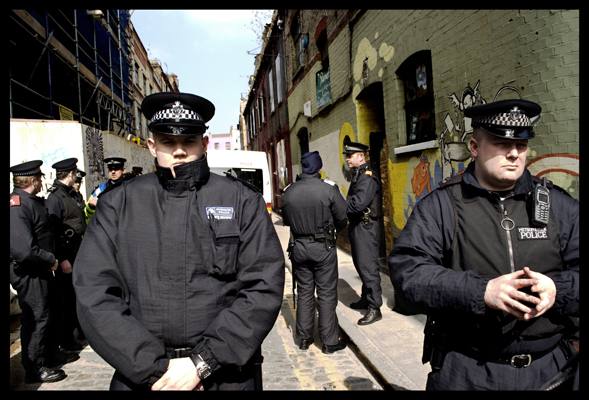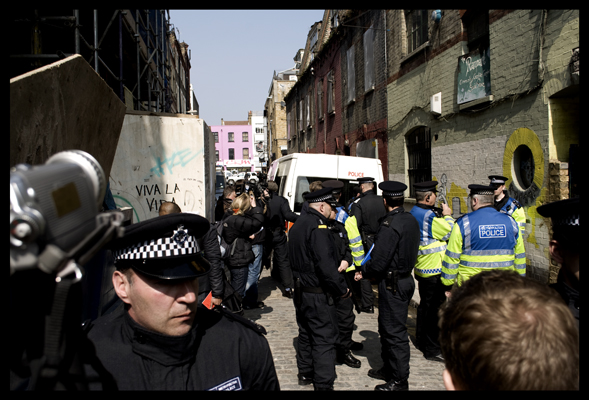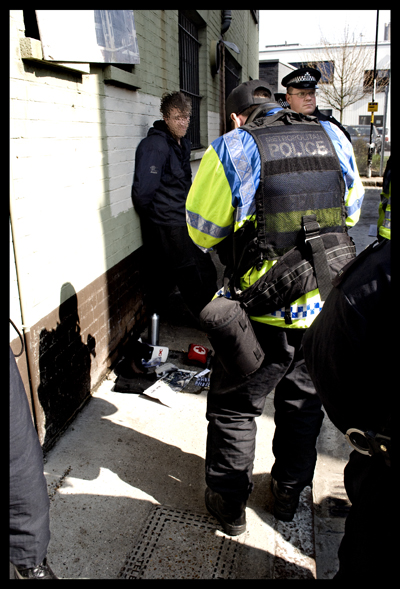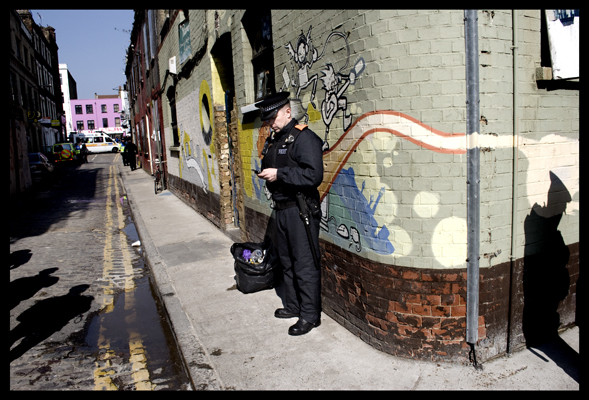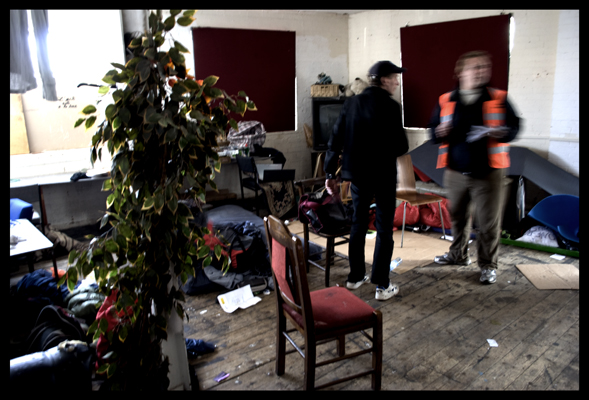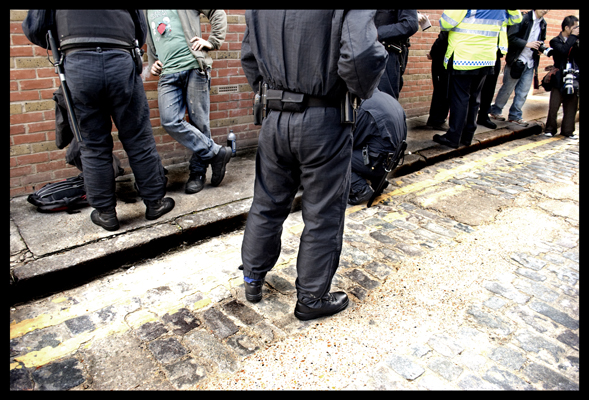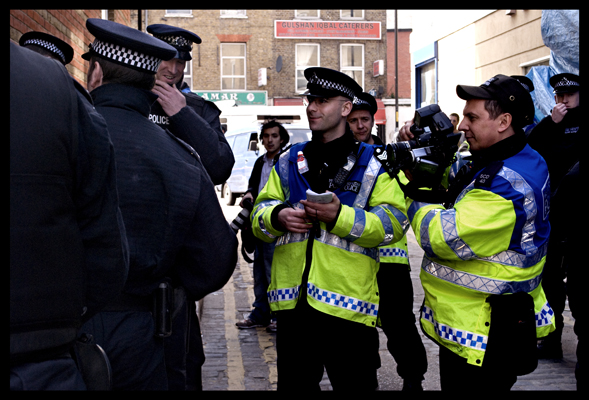How bad do things have to be for a group of people to be afraid to leave their houses because la migra might pick them up and place their family members in separate detention centers to eventually deport them? Or that people crossing the border not only have to be concerned about the environmental dangers, but also the more recent upsurge of people who kidnap migrants, steal from them, assault them, and hold them for ransom. The police or ICE commit similar atrocities, but masquerading as heroes; “saving” the immigrants from the drop houses. Many citizens believe undocumented immigrants deserve the harm or misfortune inflicted upon them because they are here “illegally”.
Nearly any debate about “illegal” immigration comes down to one thing: the law is the law. They say illegal people have no legitimate claims in “our” country. Despite the many illegal actions that people take everyday without feeling an ounce of guilt (speeding, downloading music), being in the country “illegally” is seen as a crime against the citizens. Despite the fact that many of us see this law, like so many others, as illegitimate and hypocritical based on its historical roots and the context in which it is enforced, as a means to maintain an exploitable class, as enforcement of the color line, and as a tool of government to control people and quash dissent; we seem quite silent about what we think about it.
What is largely missing from the debate on immigration is this perspective on the law. We find it difficult to convince others of these ideas who value and feel protected by the exalted law and order, and so we may not even try. What kinds of changes can we hope for if we are not willing to challenge people on their attitudes about the legitimacy of immigration law, and beyond?
The common attitudes, promoted by special interest groups and the media serve to justify the horrible treatment of undocumented immigrants and allow people to dismiss the actions of law enforcement or vigilantes as warranted. Most people know about the reasons that immigrants have to come here “illegally”, yet many would even say they deserve the worst of the terrorism they face here.
What we need to talk about is the criminalization of people- the politically/racially/economically motivated practice that has led to a vast increase in the prison industrial complex and immigration detention centers in the last several years, as well as the increased collaboration between the police and the federal government. Even though in most cases, undocumented immigrants have only committed a civil offense and not technically a crime, it is just as easily considered a crime. Of course, in addition to this, immigrants are purposefully associated with other crimes, and new laws continue to be created to further criminalize them. The war against “illegal” immigration is just one part of institutional racism, except this is an example that makes it all the more clear that crimes have been made out of the actions of people because of who they are. It is clear that the law has been used purposefully to render people powerless and exploitable.
Because so many people are not willing to touch this, it has to be us. This may only be part of the struggle, but it is necessary to challenge the way criminalization not only affects the people it criminalizes, but everyone who is treated unfairly because of their association with criminals, and everyone else in their attitudes about those people. This criminalization maintains a racism which can easily be denied- because “it’s not about race. It’s about the law.”
The focus on the law is employed so that a person’s opposition to “illegal” immigration seems to just be about the law; not about race. Those of us who are citizens, and especially those of us who are white have a responsibility to fight the racism within our communities (even the communities that we don’t feel are ours). No matter how many solidarity demos or actions against the wall or ICE, if we let the racism within the citizenry fester and increase, we can not hope to succeed. Many white people are ripe for recruitment in fascist groups. For decades, people of color have been advising white folks to organize within their own communities. Although this is a challenge, it must occur. People of color have also informed most of the concepts below, and it is important that white people take their words seriously.
The limits of current strategies
In our fight for immigrants’ rights, freedom of movement, and/or no borders, we have many challenges. The minutemen and associated groups and politicians, while not achieving as much as they had hoped in terms of law enforcement and border security, have in fact influenced many people’s thinking (with the help of well-funded FAIR and other such groups, and of course the media). Newly passed laws or even attempts at passing laws, as well as stepped up enforcement by ICE and the police have shaped people’s view of immigrants as criminals.
Despite a multitude of efforts, the minutemen still seem somewhat sensible in the eyes of many; immigrants still face the dangers of crossing the border; hate crimes, ICE raids, police sweeps, harassment and racial profiling still happen; people’s rights (the few that they have) are still violated; and the detention centers still exist. This is not to say that the organizing that’s done is pointless, but that in conjunction with these activities, we need to challenge the ideas that perpetuate this situation. There have been few efforts to challenge the legitimacy of the law. Many of the efforts attempted have not made a point of relating the racism against recent undocumented immigrants to the current and historical racism against black people and other people of color.
Immigrants’ rights advocates often accuse the anti-immigrant movement of being racist, but nothing gets the opposition to admit that race has anything to do with it (additionally, it is often about personal racism and not systemic racism). Many efforts have been made on the part of the anti-immigrant movement to maintain a non-racist appearance for the sake of appealing to the mainstream, due to racism being so taboo. Examining the comments to any online Arizona-based newspaper article on immigration will provide one with a view of this repetition about the law and a veiled, or not so veiled, hatred for outsiders (specifically Mexicans). The rule of law rhetoric creates a smokescreen over the reality of intertwined racial, economic, and political motivations behind the laws.
In the context of immigration, understanding racism is crucial but complicated. Race is a social construct, so the fact that undocumented immigrants are a diverse group of people does not matter as much in terms of how white supremacy functions. More than anything, the stereotypes about undocumented immigrants inform anti-immigrant rhetoric, policies, and enforcement (exemplified by the emphasis on the U.S./Mexican border rather than that of Canada). People’s concepts about race are complicated, mainly because race is only real in how it affects people. Class also plays a role in this context since foreigners with more wealth are not treated as a burden, and because citizenship is not available to most people, especially the poor. Undocumented immigrants, at least the ones that somewhat fit the stereotypes, are thought of and treated as inferior. It is considered acceptable that they have little access to safety, health, and dignity. A useful definition of white supremacy is from Elizabeth “Betita” Martinez: “White Supremacy is an historically based, institutionally perpetuated system of exploitation and oppression of continents, nations, and peoples of color by white peoples and nations of the European continent, for the purpose of maintaining and defending a system of wealth, power, and privilege.” Police in particular are said to enforce the color line by treating non-white people as criminals.
The attitudes people have about undocumented immigrants need to be challenged. Although they may partly be based on feeling threatened (they’re taking over), they are also based on a racism that is “justified” and shaped by the idea that the unwelcome people are criminals. These attitudes often effectively override compassion for the misfortunate. A starting point would be to engage people who are compassionate and identify as anti-racist, but build upon that to figure out how to change other peoples’ minds. An analysis of the purposeful construction of laws to criminalize undocumented immigrants would have two objectives: an end to the attitudes described above, and an end to institutionalized racism. This effort obviously applies to the criminalization of people of color in general in the United States. We cannot fight white supremacy if we do not consider the bigger picture of what has been taking place in this country.
The emphasis on the legality of people should not be confused with legalizing people exactly, but to bring attention to the politically motivated criminalization of people and to change it. Legalizing immigrants (though not very likely to happen in an acceptable way if at all) does not address many of the economic and race issues that currently exist.
Assimilation and therefore whiteness being historically accessible to Mexican-Americans especially, we should consider the ways in which the struggle should avoid the trend of maintaining a hierarchy with black people on the bottom. Martha Escobar, in “No One is Criminal” printed in Abolition Now! addresses efforts at legalization but mostly the rhetoric about immigrants not being criminals. “Thus when we claim that immigrants are not criminals, the fundamental message is that immigrants are not Black, or at least, that immigrants will not be ‘another Black problem.’ Tracing the construction of criminality in relationship to Blackness and how it is re-mapped onto brown bodies through the notion of “illegality” gives witness to the ways that criminality allows a reconfiguration of racial boundaries along Blackness and whiteness. In other words, criminalizing immigrants serves to discipline them into whiteness.” Explaining that immigrants are not criminals (via studies on crime rates, etc.) and complaining about the police or the government not putting the real criminals in jail in some ways is counterproductive.
It is also important to be concerned that most of the immigrants’ rights efforts do not address the fact that we are on stolen ground in the first place. Existing land struggles are not addressed by legalization efforts. We also tend to fail to address the relationship between the war on immigrants and the war on terror. A myopic focus on legalizing immigrants would contribute to the continuing abandonment of the past and current effects of the criminalization of people of color and cannot hope to abolish whiteness.
Suggestions
The attitudes people have are fueled by and feed the criminalization of people. We need to find ways to change people’s attitudes to undermine the racism that exists. A number of things need to be articulated in a way that is accessible to a variety of people. We especially have to be able to explain these concepts to people who don’t feel they have any interest in considering them, much less changing anything. On the other hand, there are many people who would benefit from changes and a new analysis of the function of criminalization would empower them. Either way, those of us who are in this fight need to understand the complex aspects of the immigration/criminalization issues. Below is my attempt to start to construct an analysis specifically regarding the law from which talking points can emerge.
“In order to figure out why people get locked up and under what circumstances, we need to look at what are sometimes called ‘root causes.’ This strategy requires looking at the competing priorities of the systems in which we live and understanding why they work well for some and horribly for others. The systems of race, class, gender, and sexuality, for instance, are commonly understood as privileging some people’s needs and ideals over others. By exploring why and how those systems work for some and not for others, we can begin to develop a better understanding of how to include concrete steps in our work that deal with the negative effects of these systems on the people who are most often put in cages.” –Critical Resistance
Economic Motives
We need to talk about the economic motives behind the criminalization of people and therefore the illegitimacy of the laws involved. Of particular interest are the immigration laws because immigrants are currently a huge target and because, as I mentioned above, it can perhaps be shown more easily that there is intentional politically-motivated criminalization of people. The exploitation of labor is the primary motive. This is accomplished by keeping the laboring class from uniting (divide people by race and by immigration status) and from keeping certain individuals from having the power to organize for a better situation (undocumented workers who organize in their work places are often threatened with deportation). We must also discuss the fact that undocumented workers are largely from regions that have been affected negatively by neo-liberal economic projects. These forces have led to the loss of land and other resources and an intentional lack of employment options which leaves them more exploitable. Of course there is money to also be made in the prisons and detention centers, at least for those run privately. The businesses that have relationships with these facilities (food providers, prison-related products manufacturers, investors, etc.) also profit. Homeland Security has some good deals for border security technology with companies like Halliburton and Boeing that also profit from the war in Iraq. Included also in the war against undocumented people are the funds that go into transporting immigrants by land and air. Criminalizing people of color is a lucrative business, and we are well aware that when profits are the motive, human rights are scarce.
The hope is that revealing the economic motives of certain actions would destabilize the appearance of those actions as legitimate.
The Reality of Criminalization and Immigration Detention
Many people remain ignorant about the reality of immigration detention. It would be useful to share information about the extent to which detention centers have increased in the past few years, and the fact that many are privately owned (many by corporations that also own private prisons). We should be aware of the plan devised by the Department of Homeland Security called Endgame, which seeks to remove “all removable aliens” by 2011, using new relationships between police and ICE such as 287g. With about 27,500 people in immigration detention on any given day and triple the number of detainees than just nine years ago, many immigrants in private detention, without proper care, legal assistance, and adequate understanding of their rights and recourses, we have an astounding crisis on our hands.
Immigrants are not only ending up in detention centers, but also in jails and prisons. Increasingly, yet another tactic of attrition, in order to discourage them from coming back is to imprison immigrants instead of just sending them back to where they came from. Many immigrants sign guilty pleas for crimes like identity theft, without even understanding that often the authorities have no evidence. Charging them with additional crimes also increases the consequences for coming back.
What are the forces at work? In the context of immigration, there are two manifestations of white supremacy that feed off of each other and are interconnected. One is personal prejudices, attitudes, and resulting discrimination. The second is the racism within the various institutions (such as law enforcement) that play out these previous manifestations in a less visible way. The institutional racism in turn shapes peoples’ attitudes about race. Two forces behind these manifestations of racism are the anti-immigrant movement and the business interests that employ immigrants. Because business interests enjoy the labor provided by penetrable borders, they would seem to oppose those who are interested in border security. In fact, undocumented immigrants have been used as a weapon against organized workers. While those in favor of heightened border security and internal enforcement subscribe to a more blatant racism (keep the outsiders out), the business interests also benefit from the continued and increased anti-immigrant efforts because they can profit from an exploitable, expendable (made so by the war against immigration) labor force allowed by the seemingly unconquerable stream of migration. Although these two forces have different desired means and ends, the results are the same: criminalized migrants.
Examining the history of immigration law reveals its racist history. Of course many will explain it away and insist that we have changed our regretful ways. A possible effective strategy might include showing how the U.S. concept of who belongs (white people) and who doesn’t has been shaped by immigration laws (as well as laws criminalizing Black and Native American people). The ways in which the racism and stereotyping of the Chinese led to and fed off of the Chinese Exclusion Act of 1882 mirrors the anti-Mexican sentiment in a lot of ways today. Many groups and individuals have been excluded or deported because they were seen as political threats to the country. In 1924, the National Origins Quota passed, which was due to WWI-related fears of foreign people. It strictly limited immigration from eastern and southern Europe. Later in 1952, quotas for immigration from Asian countries were severely limited. The national origins quota was abolished during the civil rights era, but is still biased in many ways. Shortly after September 11, 2001, the federal government broke its own laws holding various immigrants from mostly Middle-Eastern countries in custody for too long without deporting them or charging them with any crime.
Prior to the last few decades, only pockets of the population had any concern over “illegal aliens”. During the 80’s and 90’s the wide-ranging anti-immigrant rhetoric was similar to that of today, but was largely unpopular. Due to September 11, 2001 and the recession around that time, just like other times of economic hardship and other turmoil, immigrants became scapegoats. Mexicans especially became targeted because they were coming in at higher rates after the 1994 launch of the North American Free Trade Agreement (NAFTA). Especially in 2003 when the Minuteman Project started, the media and various politicians (both directly or indirectly influenced by business interests and/or nativists) stepped up the anti-immigrant message. The state is primarily responsible for constructing the idea of “illegal aliens”. It is now mostly socially acceptable to hate on immigrants. But the intolerance for undocumented immigrants cannot be separated from the history of American racism.
Race & Criminalization
“Crime is thus one of the masquerades behind which ‘race,’ with all its menacing ideological complexity, mobilizes public fears and creates new ones.
-Angela Davis, Prisons, Repression, and Resistance
We need to connect this reality with an analysis of the system of criminalization of people of color, historically and currently. History shows many examples of the law being used for racist ends, whether it be the blatant racism of the slavery era, or the veiled racism of the reconstruction era when black men were accused of a number of crimes such as vagrancy and subsequently sent to work as punishment. In effect, business interests were able to continue to profit from the labor produced by repression: convict leasing, or “Slavery by Another Name” as it was called by author Douglas A. Blackmon. Although it may be difficult to convince someone that the laws that are currently on the books are racist, certainly we can talk about how the law is easily manipulated to be racist, including the constitution. “Neither slavery nor involuntary servitude, except as a punishment for crime where of the party shall have been duly convicted, shall exist within the United States, or any place subject to their jurisdiction,” says the 13th Amendment to the U.S. Constitution.
As it gradually became socially unacceptable to kill or enslave people, the moral way to deal with them was to treat them as criminals, such as placing American Indian children in prison-like Indian schools. People who are considered of lesser value and who can be contrived as “other” can easily be used for the benefit of those in power.
Not so long ago, Richard Nixon said, “You have to face the fact that whole problem is really the blacks. The key is to devise a system that recognizes this while not appearing to...” In a letter to Dwight Eisenhower, he wrote, “I have found great audience response to this [law and order] theme in all parts of the country, including areas like New Hampshire where there is virtually no race problem and relatively little crime.” With blatant racism being frowned upon, there have been many examples of ways people of color have been especially painted as being more likely to commit crime, even though there are many examples of worse crimes that rich white men commit that are not considered worthy of our attention. Much of people’s racism is manufactured by the idea that people of color tend more often to be criminals. Examining the increase in the prison industrial complex and the drug war can provide us with various insights into specifically politically-motivated measures taken up against people of color.
Institutionalized racism in the form of law and order results in complex effects on people of color. One effect is that people of color disproportionately get caught up in the criminal “justice” system. Although this has happened because of its historical roots, today it “justifies” the treatment of most people of color as criminals. This means that even someone who has not committed a crime can be killed, brutalized, or harassed by the police because of their association with criminals due to their darker skin. Sexual assault or harassment against women of color is allowable in the context in which they are associated with criminality.
Sylvanna Falcón in “’National Security’ and the Violation of Women: Militarized Border Rape at the US-Mexico Border” printed in The Color of Violence examines how this effects immigrant women. “The cases of militarized border rape… can be categorized as a form of “national security rape”… [T]he absence of legal documents positions undocumented women as ‘illegal’ and as having committed a crime... the existence of undocumented women causes national insecurity, and they are so criminalized that their bodily integrity does not matter to the state…”
We can see that “national security” most certainly does not refer to the health, safety, and dignity of the nation’s residents, but instead protects the state.
The media plays a large role in perpetuating ideas about who to feel threatened by, which in turn affects peoples’ attitudes about and behavior towards others and themselves. Although nearly every person of color is in some way touched by the criminal “justice” system, there are efforts made to maintain an image of non-racism, in which the elite allows people of color certain privileges and access to status. This produces the idea of the criminal people of color vs. the non-criminal person of color, thereby maintaining the legitimacy of the criminal “justice” system.
The U.S. prison population is the highest in the world. One out of every 133 U.S. residents is behind bars. “Compared to the estimated numbers of black, white, and Hispanic males in the U.S. resident population, black males (6 times) and Hispanic males (a little more than 2 times) were more likely to be held in custody than white males. At midyear 2007 the estimated incarceration rate of white males was 773 per 100,000… At midyear 2007, the incarceration rate of black women held in custody (prison or jail) was 348 per 100,000 U.S. residents compared to 146 Hispanic women and 95 white women” (drugwarfacts.org). Women have been entering prisons at higher rates than men. Even when women of color are not directly criminalized, they are treated as reproducers of criminals, while prisons function as an attack on their reproductive freedom and their ability to maintain healthy family structures.
We should also look at the ways in which this benefits the government and the social order. Many efforts have been made by the poor and people of color to change or overthrow the government and economic system. Dividing the working class by race has been a wise strategy to weaken the power of the people. In addition, imprisoning dissidents of various sorts under the guise of law enforcement (remember, we don’t have any political prisoners) is also a tactic against successes of various liberation movements, especially the Black and American Indian movements.
We can also see that putting people in prison instead of solving problems such as poverty and drug abuse is the chosen course of action by the state, because the idea is not to resolve these problems in the first place but to appear to do so while at the same time dealing with the issues in the most useful way to those in power. The government obviously has inextricable ties to business, so maintaining a good relationship is a large factor in the law enforcement that takes place. Those in the government also have a lot to gain from an increase in wealth secured through exploitation of a criminal class. And finally, the government has a lot to gain from an image of control, which can be achieved through Homeland Security and law enforcement.
Many examples exist of ways in which crime-fighting is not, in fact, intended to end the activities which are considered crimes. The government has no interest in ending crime unless it is targeted towards the government itself, the rich or their property. One could list a number of crimes committed by people who get away with it everyday, and a number of acts that should be crimes because they hurt people, other beings, and/or the planet, yet they are not crimes because it is not in the interest of the government to control those actions. Crimes against people who are seen as less valuable are not important to enforce unless it benefits the system in another way. Black on black violence, for example is acceptable to the criminal “justice” system and is even encouraged. Crimes committed by government, government agents, businesses, are treated differently, with the perpetrators facing much less harsh punishment than their civilian counter-parts face, if any. Often crimes are enabled by involvement with the government such as the drug trafficking done with government vehicles and physical and sexual abuse by police, border patrol, and prison officials, yet the criminals in these cases are treated as a few bad apples.
Much of the history of illegalization of drugs is linked directly to racism. Marijuana was associated with Mexicans and Black people, opium with the Chinese. The drug war has created many new criminals. More than half of people in federal prison are in for drug offenses. We also see how the use of crack, associated with Black people, is disproportionately punished compared to that of cocaine, more associated with white users. Some interesting parallels exist between the drug war and the war against “illegal” immigration, which deserve further examination elsewhere. A notable parallel lies in the fact that the criminalization of the respective activities has created underground markets and added crooked criminal activity.
The illegalization of certain underground activities (drugs, immigration, prostitution) relegates the participants (willing or unwilling) to having little access to the “justice” system or community support, and in fact makes those without the means to escape, vulnerable to violence and exploitation. Often more money is to be made when access to something (such as free movement) is restricted and desperation is higher. The result is that some are terrorized by others and it is of no concern to the citizens who implore that the laws be enforced. The work of the coyotes has been increasingly carried out by elements of organized crime such as the drug cartels. The violence of the Mexican drug cartels is touching the U.S. more and more. Immigrants get kidnapped and held for ransom, people are sexually assaulted or worse. Communities along the border, especially non-white communities like the O’odham are terrorized by those in the drug trade as well as those “fighting” the drug traffickers. This cannot be viewed in a simplistic fashion. We cannot ignore that the criminalization is what has created these situations.
“It is important to recognize how violence--not only in Ciudad Juarez, but also in Mexico City--is not simply a problem for the state but is in fact endemic to it, a ‘state of exception’ produced by an authoritarian government that has cultivated extreme forms of violence, corruption, and yes, even death, in order to cripple people’s capacity to resist, to smother effective counterdiscourse and over-power the revitalized democratic opposition... We should consider femicide in Ciudad Juarez as part of the scenario of state-sponsored terrorism...”
Regarding Rosa Linda Fregoso’s quote from “The Complexities of ‘Feminicide’ on the Border” (from The Color of Violence), it is impossible to separate the actions (and inactions) of the Mexican government from the influence of the governmental and economic forces based in the United States. The impacts of colonialism and neoliberalism and the resulting poverty, corruption and anti-resistance efforts have profound consequences.
It is worth noting that the drug war, just like the war against immigrants, is not intended to actually stop the flow. The U.S. government is spending over one billion dollars “helping” the Mexican government deal with the drug cartels through the new Plan Mexico or Merida Initiative. They could instead be decriminalizing drugs or curtailing demand by increasing what has been proven to be effective: treatment. Let us also not ignore the many cases in which government officials (U.S. and Mexican) are directly or indirectly involved in the drug trade.
Law enforcement officials act like they are heroes when they save the captives of human traffickers, or when they rescue perishing immigrants crossing the harsh desert; even though they enforce the laws that produce these conditions in the first place.
Conclusion
Is it not a bigger crime that people are afraid to leave their houses? White supremacy means some lives are more valuable than others and what results is danger, repression, and punishment for those who are not considered white.
What do we do about all of this? Institutional racism and individual white supremacy feed off of each other. We should consider ways to struggle against instituational racism, although many disagree on how. At the very least we can keep white people from joining white supremacist militias, and ideally get those people to act on behalf of immigrants and other people of color.
In our efforts, whatever those look like, we need to understand the issues discussed above and be able to explain them to other people. Art, posters, fliers, press releases, articles, demonstrations, one-on-one debates, etc., need to reach a variety of people so they can gain a better perspective on the whole picture. We need to influence the various movements in favor of ending oppression overall, not just a single group of people, and not in a superficial way.
It is hopeful to see many people mobilized against detention centers. The general feeling tends to be that the people do not deserve to be imprisoned because they haven’t done anything to justify that. Hope resides in people’s realization that the government would imprison innocent people- that the law isn’t legitimate. The relationship between the detention centers and the prison industrial complex as a whole needs to be highlighted so that people can see that the immigration detention centers are not the only unmerited manifestation of imprisonment of people. It is also vital that the people see a common cause in dealing with these issues in a larger context.
As far as dealing with institutional racism, organizations such as Critical Resistance, INCITE!, and copwatch groups have been developing responses to institutional racism in the form of law enforcement and the prison industrial complex. While many immigrants’ rights strategies are myopic, these groups tend to have a more inclusive perspective. The most powerful efforts to bringing justice to undocumented immigrants must involve uniting people who are affected by the criminal “justice” system and coming up with alternatives to dealing with social problems using that system. Supporting the efforts that existing groups like these are doing may be a good place to start.
Solving the “immigration problem” will not mean securing the border, nor the legalization of immigrants, nor will it mean shifting around a few things so we can again easily ignore immigrants and allow them to remain exploited. Radical changes will have to occur- things that are very threatening to the status quo and would therefore likely encounter the criminal “justice” system as well. It is also not okay if somehow immigrants are given justice; there is already a system of oppression against people of color that will not be resolved unless we connect these issues. Small successes are good, but if we do not demand the fullest extent of what needs to change, we cannot have any hope of gaining it. Angela Davis’s quote below can be related to today’s struggle.
“If convict leasing and the accompanying disproportionality with which black people were made to inhabit jails and prisons during the post-Emancipation period had been taken up with the same intensity and seriousness as- and in connection with- the campaign against lynching, then the contemporary radical call for prison abolition might not sound so implausible today.” Angela Davis: From the Prison of Slavery to the Slavery of Prison
















